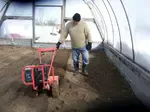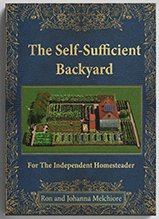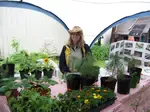Why you should consider starting a greenhouse on your small farm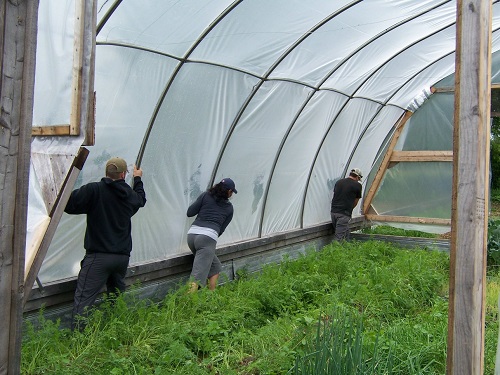 Farm crew moving my hoophouse on rails Farm crew moving my hoophouse on railsStarting a greenhouse was a natural offshoot of my Community Supported Agriculture (CSA) market garden business; I built my movable greenhouse on rails (a la Eliot Coleman) as well as a lean-to greenhouse and a small version built from cattle panels. Here's my experience working with them, so you can evaluate the benefits of starting a greenhouse for yourself.
Greenhouse construction
My movable greenhouse (actually a hoophouse) is mounted on wooden rails that are a little more than twice the length of the hoophouse itself. I buried flashing (used steel roofing) around the base of the rails to keep out rodents.
I also installed a ventilation fan in one end wall. The entire hoophouse, including the end walls, is covered by a single layer of poly. In Canada, the company I have used for many years is Harnois Greenhouses. They have great prices for greenhouse plastic. In the US, check out the selection of greenhouse plastics from Bootstrap Farmer. They also offer a DIY hoop house kit that includes the plastic cover. You can read my review here. 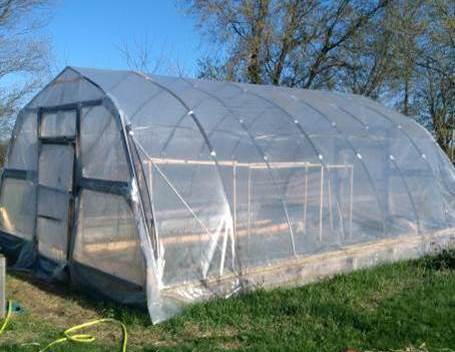 My greenhouse on rails My greenhouse on railsMy lean-to is built from the same hoops; we used half-hoops framed against the south-facing gable end of one of my outbuildings. The base frame is a 10' x 16' rectangle built out of 2x8. The top of the half hoops are secured to a ledger beam about 11 feet up the wall. End wall framing is made of 2x4 bolted to the hoops. 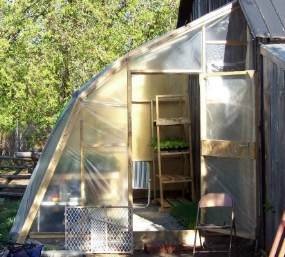 My little lean-to is very useful for plant starting in spring My little lean-to is very useful for plant starting in springGreenhouse Planting
When I considered starting a greenhouse, I knew I wanted a movable design. Being able to easily move the greenhouse to a new location effectively doubles the greenhouse growing area. I can also take advantage of seasonal and site-specific growing conditions.
Here's my basic movable greenhouse planting plan Beginning in early spring (first week of March in my area, still lots of snow on the ground) I built raised beds in the hoophouse. The 20-foot width of the hoophouse allowed me to construct 5 beds. I left about 2 feet between the side walls of the hoophouse and the first beds; this was to provide some distance from the outside cold and also to allow room for me to grow flats of transplants and bedding plants there later in the season.
I did leave a few broccoli in the hoophouse, to see how they would fare compared to the outdoor garden. The broccoli plants in the greenhouse were harvest-ready 3 weeks before the ones I transplanted out.
They were ready 4 weeks before the first harvests from the outdoor garden. This early harvest alone was enough to justify starting a greenhouse.
Then I will move it back to the first position, where I will have planted more hardy crops for the fall. This second move means I get triple use from my little hoophouse.
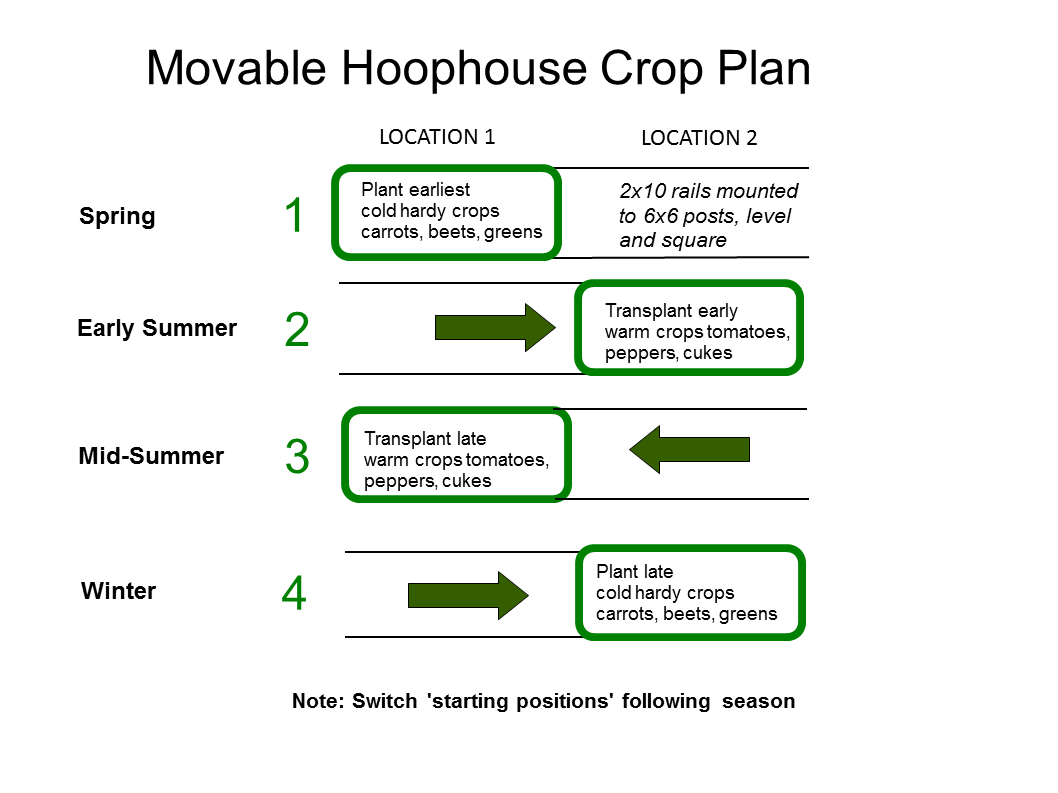 Each 'move' takes about 2 hours with some helpers Each 'move' takes about 2 hours with some helpersGreenhouse ProductionDoes this greenhouse production justify the the time and expense? At the time, my movable greenhouse (if every component was bought new) would cost less than $2,000. Hoophouses are usually constructed on a base, so the incremental cost to make it slidable (some more 2x6 and 2x4 for the additional length of rail, more used steel flashing) was about a couple hundred dollars. For this incremental cost (about 10%), I got triple the growing area of a fixed greenhouse.
Other links of interestHere's my curated list of micro-farm equipment for the small grower Check out some great products for farmers and gardeners here farm grown reviews This is a pretty good article about Urban Survival. You might also want to up your survival game with my Homestead Book Bundle For the backyard growerI didn't write this one, but it's an excellent resource for the homesteader or small property owner anyway! The Self-Sufficient Backyard has literally hundreds of plans and practical tools and techniques for the serious homesteader.Written by a couple who have actually done the work. From growing food, to medicinal herbs, solar electricity, root cellaring, growing small livestock, and selling select produce as a side hustle, plus many more money-saving and money-making ideas, this book is an encyclopedia of growing and building knowledge. A must-have in your homestead library. I only write about topics I have personal experience with. The authors of The Self-Sufficient Backyard have done the same. Highly recommended! Free Market Garden Guide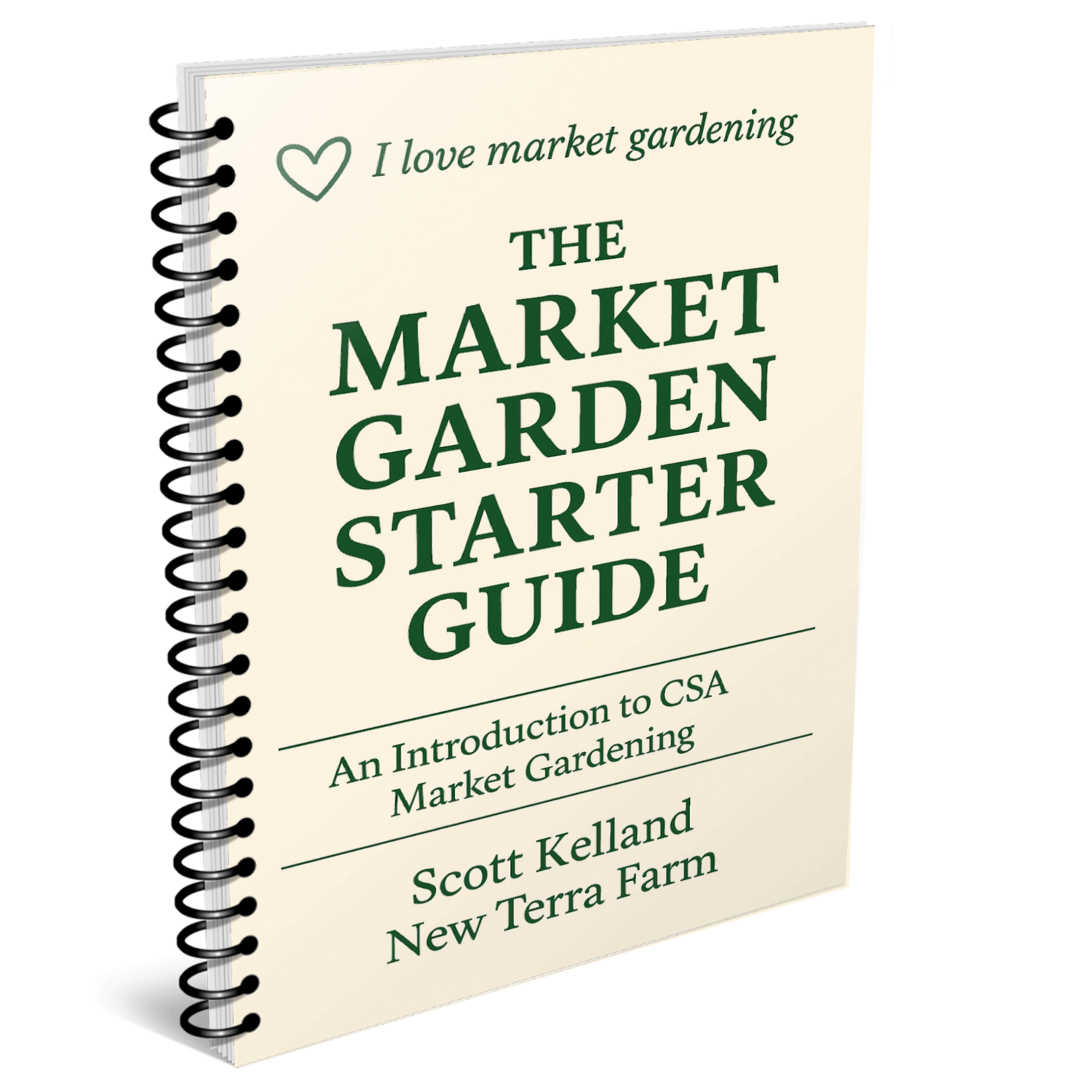 The consumer demand for fresh local organic food has never been higher. Bad news on the supply chain is good news for local growers. Get my free Organic Market Gardener Start-up Guide and see if this is the right time to launch your CSA market garden business. Download it here
|
See Something You Like? Share!
Got questions to ask, stories to tell?
Share your organic market gardening question, or comment, or story.
Recent Articles
-
How to Become a Homesteader: Start Small, Build Smart, Live Free
Oct 28, 25 07:31 AM
How to become a homesteader, the practical path to homesteading success. Learn how to start small, earn early, and build real self-reliance -
Farm training for the new or wannabe farmer
Oct 27, 25 02:12 PM
Practical farm training from award-winning New Terra Farm -
How to Buy a Farm: A Practical Guide for First-Time Growers
Oct 26, 25 07:49 AM
Learn how to buy a farm the smart way — without debt, regret, or overwhelm. Discover the steps to find, fund, and thrive on your first piece of land
